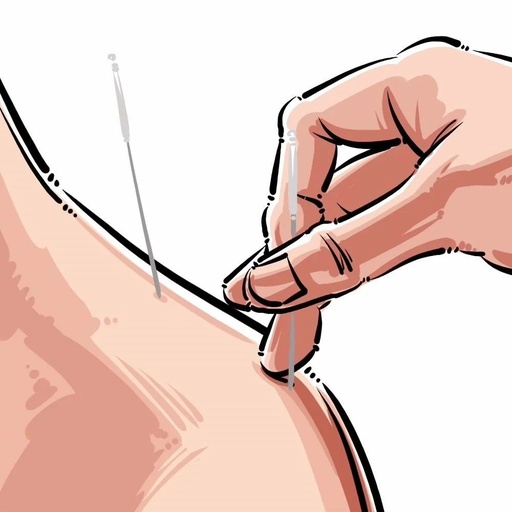Warm Reminder
This section aims to introduce the basic knowledge of acupoints in the human body, allowing everyone to have a fundamental understanding of them and a simple grasp of their application in external therapies such as moxibustion, cupping, and guasha. Many acupoints have high risks associated with needling; non-professionals in acupuncture should not attempt needling operations!
The Foot Taiyang Bladder Meridian
🔹 Meridian Pathway
The Foot Taiyang Bladder Meridian begins at the inner canthus of the eye (Jingming), following the path through the acupoints of Zanzhu, Quchao, and Wuchu, ascending to the forehead and vertex, entering Chengguang, and continuing to Tongtian, where it branches off to connect with the Foot Shaoyang Gallbladder Meridian.
The branch of the Foot Shaoyang Gallbladder Meridian runs from the vertex to the upper corner of the ear, connecting with the Foot Shaoyang Gallbladder Meridian.
The main pathway of the Foot Taiyang Bladder Meridian runs from Tongtian, connecting to Dazhu, then following the pathway to the inner Fengmen, and continuing to the Feishu, along the spine to the waist, reaching the Jueyin point, and further to the Xinshu, Dushu, Ge Shu, Gan Shu, Dan Shu, Pi Shu, Wei Shu, Sanjiao Shu, and entering the kidney through the Liao point. From the Shenshu, it continues to the Qihai point, and from the waist down, it follows the spine to the Dazhong point, then to the Guanyuan, Bladder Shu, Zhong Liao, Baihuan, and other points, branching off to the upper, middle, and lower sacral points.
The Foot Taiyang Bladder Meridian also has a branch that runs from the shoulder, following the Fufen point to the Guanchang point, then continuing along the spine to the internal Gao Huang, Shentang, Yixi, Geguan, Hunmen, Yanggang, Yishe, Weicang, Huangmen, Zhishi, and Baohuang points, passing through the hip joint, and descending along the thigh to the popliteal fossa (Weizhong). From Weizhong, it connects to Huyang, descending to the inner Chengjin point, and continuing to Chengshan, Feiyang, and Fuyang. From Fuyang, it runs to the external malleolus, reaching the Kunlun point (meridian point), and continues to Puzhen, Shenmai, and Jinmen. It then follows the Jinggu point of this meridian, passing through the Shugu and Tonggu points to the outer side of the little toe (Zhiyin).
The Foot Shaoyin Kidney Meridian connects with the Foot Taiyang Bladder Meridian at the Zhiyin point at the end of the metatarsal bones.
According to the “Encyclopedia of Traditional Chinese Medicine”: The Foot Taiyang Bladder Meridian starts from the inner corner of the eye (Jingming), ascends to the forehead (Shenting), and meets the Du Meridian at the top of the head (Baihui). Its branches extend from the top of the head to the upper corner of the ear. The main trunk runs straight into the skull, connecting with the brain, and exits from the back of the neck, splitting to descend along both sides of the spine, reaching the waist, where it penetrates deeply, following the muscles along the sides of the spine, connecting with the kidneys, belonging to the bladder. The branches at the waist continue down through the buttocks, entering the popliteal fossa (Weizhong). Another branch runs from the back of the neck down, from the inner edge of the scapula, directly to below the scapula, along the spine, passing through the hip joint, descending along the back of the thigh, and meeting the anterior branch in the popliteal fossa. From there, it descends through the gastrocnemius muscle, exiting behind the external malleolus, along the fifth metatarsal tuberosity (Jinggu) to the outer side of the little toe (Zhiyin). The meridian qi connects with the Foot Shaoyin Kidney Meridian here.
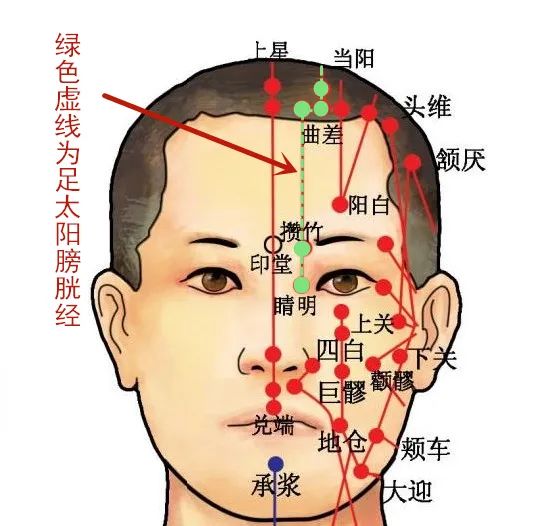
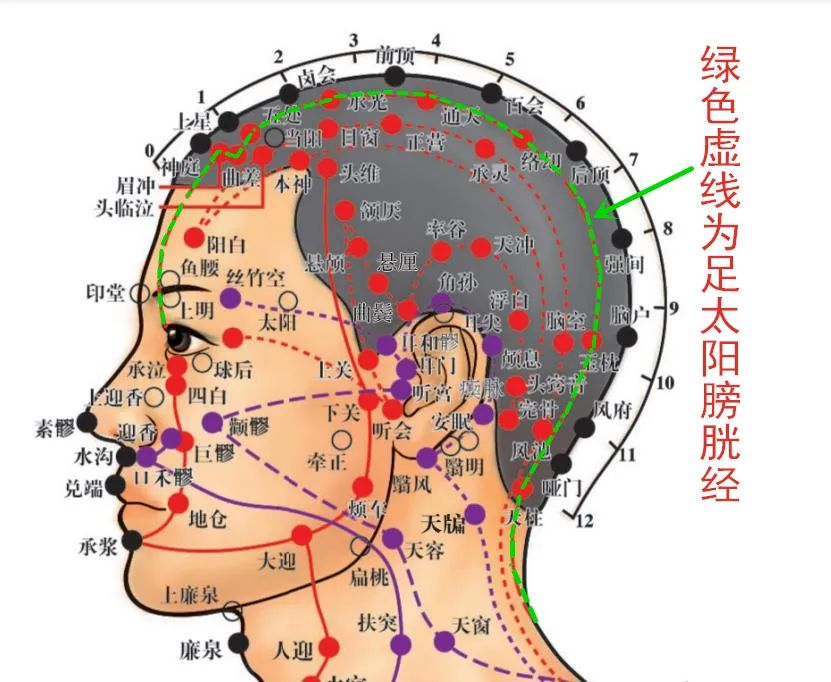
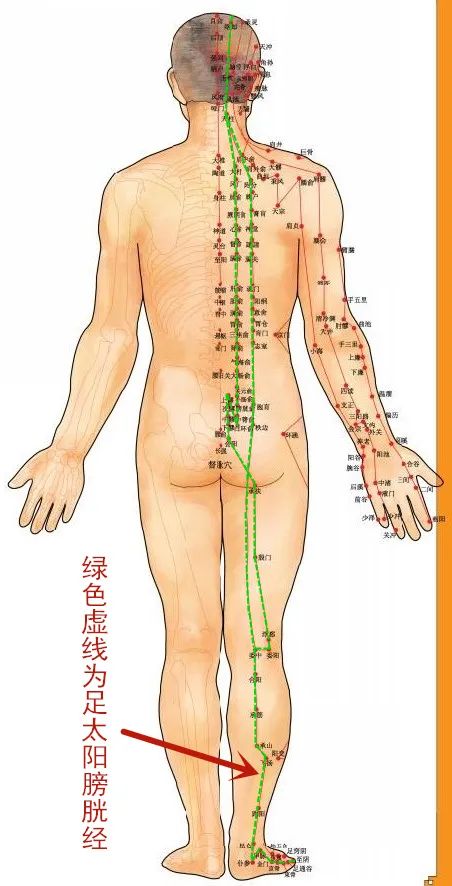
🔹 Summary of Indications
The Foot Taiyang Bladder Meridian treats diseases such as epilepsy, headaches, stiff neck, low back pain, eye diseases, difficulty in flexing the hip joint, calf pain when bending the knee, hemorrhoids, malaria, neurasthenia, menstrual irregularities, jaundice, and nasal discharge or bleeding.
Acupoints of the Foot Taiyang Bladder Meridian
🔹Weizhong Point (He Point; Lower He Point of the Bladder)
[Source] “Huangdi Neijing Ling Shu: Ben Shu”: Entering Weizhong.
[Location] At the midpoint of the popliteal crease, between the tendons of the biceps femoris and semitendinosus.
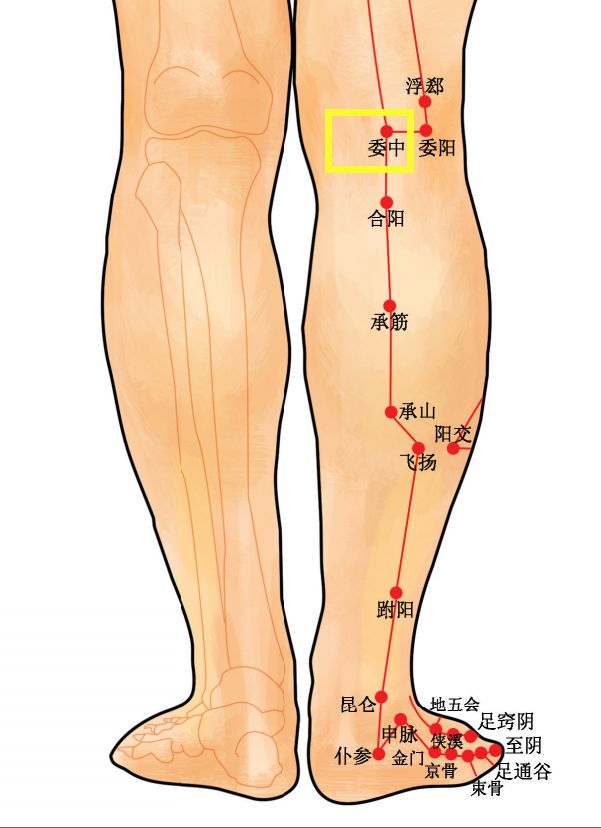
[Indications]
1. Low back pain, lower limb paralysis, and other conditions of the waist and lower limbs;
2. Low back pain, acute vomiting and diarrhea;
3. Difficulty urinating, enuresis;
4. Erysipelas.
[Applications]
The Weizhong point has the effects of relaxing muscles and activating collaterals, clearing heat and relieving summer heat, cooling blood and detoxifying.
The Weizhong point is indicated for diseases of the waist, legs, gastrointestinal tract, and areas traversed by this meridian: such as low back pain, hip pain, wind-cold-damp obstruction, hemiplegia, muscle spasms, beriberi, erysipelas, headaches, dizziness, blurred vision, epistaxis, back cold, shoulder heat, axillary swelling, lower abdominal swelling and pain, cold extremities, difficulty urinating, enuresis, hemorrhoids, cholera, vomiting and diarrhea, dysentery, epilepsy, convulsions, malaria, summer heat, back sores, itching skin, and various skin lesions. In modern practice, the Weizhong point is often used to treat acute lumbar sprains, sciatica, heat stroke, acute gastroenteritis, knee arthritis, lower limb paralysis, gastrocnemius muscle cramps, epistaxis, knee swelling and pain, low back stiffness, acute gastroenteritis, enteritis, urinary retention, sequelae of cerebrovascular diseases, eczema, rubella, urticaria, psoriasis, boils, low back pain, rheumatic knee arthritis, and nasal bleeding.
When combined with Shenshu and Yaoyangguan, it has a strong effect on relieving low back pain and activating collaterals.
When combined with Quchi and Fengshi, it has the effect of dispelling wind, clearing heat, and cooling blood, indicated for eczema and boils.
When combined with Yanglingquan and Xuanzhong, it has the effect of tonifying marrow, strengthening tendons, and activating blood circulation, indicated for lower limb paralysis.
When combined with Dazhui, Quchi, and Zusanli, it treats skin diseases.
When combined with Chize and Zusanli, it treats acute vomiting and diarrhea.
When combined with Huantiao, Shenshu, Yanglingquan, and Zusanli, it treats low back pain and lower limb numbness.
Special massage: Firmly pressing the Weizhong point 20-30 times can relieve acute low back pain.
Moxibustion with 5-7 cones; or stick moxibustion for 10-15 minutes.
[Literature]
“Huangdi Neijing Ling Shu: Evil Qi and Zangfu Disease Forms”: For bladder diseases, the lower abdomen is swollen and painful; pressing it causes a desire to urinate but unable to do so, with heat in the shoulder and the little toe feeling hot, take Weizhong.
“Zhenjiu Jia Yi Jing”: For heat disease with back pain, Weizhong is the main point. For malaria, heavy head, cold back, first cold then heat, thirst without relief, and sweating, Weizhong is the main point. For muscle spasms and body heat, hard swelling in the lower abdomen, difficulty urinating, cold in the buttocks and hip pain radiating to the side, and internal control of the eight sacral points, Weizhong is the main point. For epilepsy and convulsions, Weizhong is the main point.
“Zhenjiu Dacheng”: For severe wind causing hair loss, needle it to cause bleeding.
“Beiji Qianjin Yaofang”: For low back pain radiating to the head, needle it to cause bleeding; for chronic skin lesions, it will also resolve immediately.
“Tongren Shuyou Zhenjiu Tujing”: For heavy low back pain, inability to lift the body, heat disease with no sweating, and hot feet, take Weizhong.
“Leijing Tuyu”: For severe wind causing hair loss, first cold then heat, heavy sweating, heavy head, low back pain, hemiplegia, enuresis, hard lower abdomen, and weak feet. For those with kidney and bladder excess causing low back pain, needling to cause bleeding is effective; for deficiency, it is not advisable to needle, be cautious. This point is used to dispel heat from the four limbs. Weizhong is a blood point; for heat diseases with no sweating, difficulty urinating, epistaxis, stiff back, convulsions, and epilepsy, needling this point will lead to immediate recovery.
*Acupoint images are from the book “Illustrated Huangdi Neijing” published by Zitu Publishing.
Cover | Eight Years Old
Editor | Xiangru

